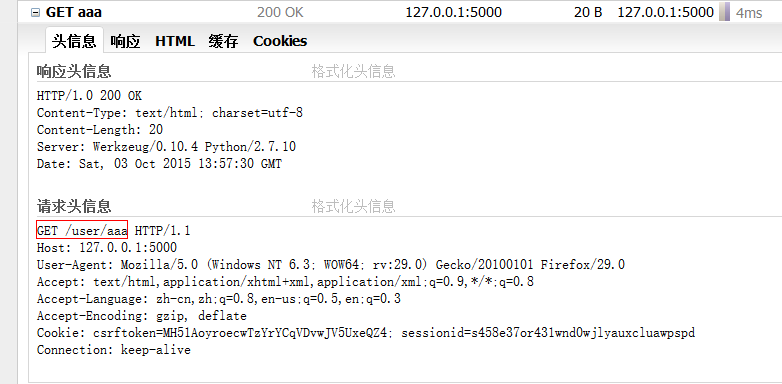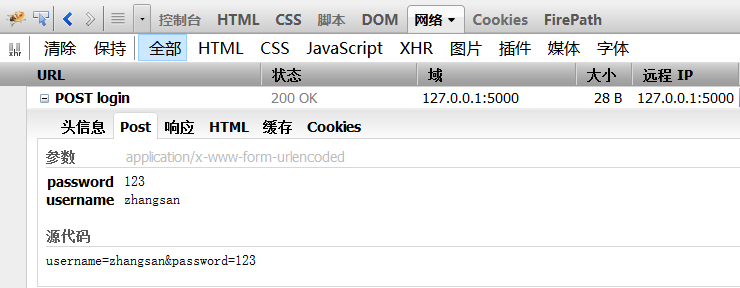web接口测试之GET与POST请求
目录
前言:
GET请求
POST请求
前言:
Web接口测试中最常见的请求方法是GET和POST,它们构成了大部分的Web API请求。在接口测试开发过程中,了解它们的原理、特点和应用场景是非常重要的。在本文中,我们将详细讨论GET和POST请求的概念、区别、使用场景以及在接口测试中的应用。
关于HTTP协议,我考虑了一下觉得没必要再花一节内容来介绍,因为网上关于HTTP协议的介绍非常详细。本着以尽量避免介绍一空洞了概念与理论来介绍接口测试,我这里仍然会给出具体实例。
在此之前先简单的介绍一下基本概念:我们想要打开一个网站,首先是需要往浏览器的地址的URL输入框架中输入网地址。当我敲下回车后,通过HTTP协议,将网址传送到域名解析服务器,域名解析服务器根据网址找到对应的IP主机(系统服务器)。这个过程叫request,即请求;当IP主机拿到请求后,将相应的资源返回给用户浏览器。这个过程叫response,即响应。
当用户浏览器向系统服务器请求时,有几种方法,最常用的就是GET和POST两种方法。
在此我们来开发这样一个可以接收GET和POST请求的web应用。当然,这里就要求读者具备一定的web开发基础了。但不编程语言与web框架不是我们讨论的重点。
以flask框架的代码为例。
GET请求
pyfl/ |---- /hello.py |----/templates/ |----|-----------/index.html |----|-----------/user.html
hello.py
from flask import Flask,render_template
app = Flask(__name__)
@app.route("/")
def index():
return render_template("index.html")
if __name__ == '__main__':
app.run(debug=True)index.html
This is index page
启动flask容器:
访问:http://127.0.0.1:5000/
通过firebug查看GET请求信息:
当然,这个返回只是一个静态的页面,并且不需要任何参数,我们只需要判断返回是否为200即可。
扩充hello.py如下:
from flask import Flask,render_template
app = Flask(__name__)
@app.route("/")
def index():
return render_template("index.html")
@app.route("/user/")
def user(name):
return render_template("user.html",name=name)
if __name__ == '__main__':
app.run(debug=True) user.html
Hell, {{name}} !
访问:http://127.0.0.1:5000/user/aaa
相比较来说,这个GET请求就复杂了一些,在请求的时候跟了一些参数(aaa),后台(hello.py)对参数了进行了接收,并且将其反回到了user.html页面中。
这个时候,我们就可以对这个参数做一些简单的测试,比较参数为空,字符,数字,脚本,sql 之类的。其实,安全测试的sql注入也是通过输参中带入sql语句入手的。
POST请求
pyfl/ |---- /hello.py |----/templates/ |----|-----------/index.html
hello.py
from flask import Flask,render_template,request
app = Flask(__name__)
@app.route("/")
def index():
return render_template("index.html")
@app.route("/login",methods = ['GET', 'POST'])
def login():
if request.method == "POST":
username = request.form.get('username')
password = request.form.get('password')
if username=="zhangsan" and password=="123":
return "welcome, %s !
" %username
else:
return "login Failure !
"
else:
return "login Failure !
"
if __name__ == '__main__':
app.run(debug=True)index.html
username:
password:
访问:http://127.0.0.1:5000/
输入用户名,密码登录(后台hello.py判定,用户名为“zhangsan”,密码为“123”登录成功,其它帐号失败。)
Python的有一个requests库,可以很方便的模拟测试POST请求。
#coding=utf-8
import requests
s = requests
data={"username":"zhangsan","password":"123",}
r = s.post('http://127.0.0.1:5000/login', data)
print r.status_code
print r.headers['content-type']
print r.encoding
print r.text执行结果:
200
text/html; charset=utf-8
utf-8
welcome, zhangsan !
POST接口的测试也一样,通过不输入为空,或错误的用户名密码,检查返回的内容。
作为一位过来人也是希望大家少走一些弯路,希望能对你带来帮助。(WEB自动化测试、app自动化测试、接口自动化测试、持续集成、自动化测试开发、大厂面试真题、简历模板等等),相信能使你更好的进步!
留【自动化测试】即可【自动化测试交流】:574737577(备注ccc)![]() http://qm.qq.com/cgi-bin/qm/qr?_wv=1027&k=jQ7U9aFlFfNPtwTDUR5iRvU_0ZJpqQnj&authKey=VpDbgWhgOhQD%2F3fnncM8ovCA0z%2F5lztJw0ZrSFg74qMtMi9Xnp99%2FCVOWixq2%2Bny&noverify=0&group_code=574737577
http://qm.qq.com/cgi-bin/qm/qr?_wv=1027&k=jQ7U9aFlFfNPtwTDUR5iRvU_0ZJpqQnj&authKey=VpDbgWhgOhQD%2F3fnncM8ovCA0z%2F5lztJw0ZrSFg74qMtMi9Xnp99%2FCVOWixq2%2Bny&noverify=0&group_code=574737577





